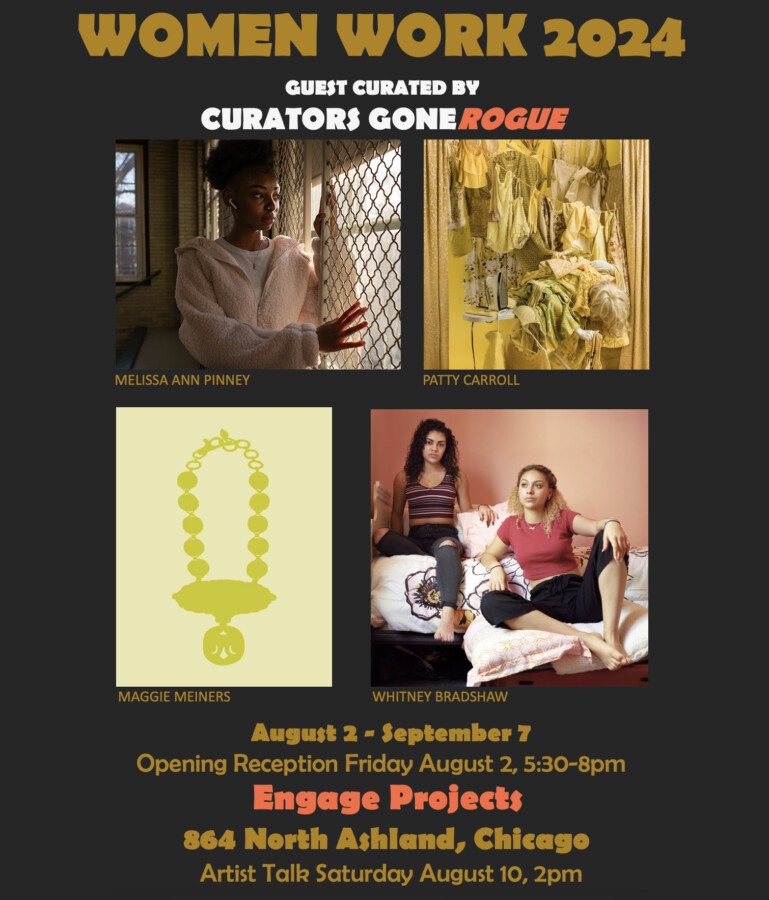Women Work 2024
@ ENGAGE Projects
864 N Ashland Ave, Chicago, IL 60622
Opening Friday, August 2nd, from 5:30PM - 8PM
On view through Saturday, September 7th
Guest Curated by Susan Aurinko and Susan Blackman with work by
Melissa Ann Pinney, Patty Carroll, Maggie Meiners, and Whitney Bradshaw
As part of our curatorial outreach, ENGAGE Projects welcomes Susan Aurinko and Susan Blackman to rethink our gallery space for our end-of-summer exhibition Women Work 2024. The guest-curator duo brilliantly puts in conversation four artists including Melissa Ann Pinney, Patty Carroll, Maggie Meiners, and Whitney Bradshaw, all working within themes of visibility and invisibility, negotiating our collective and individual understandings of womanhood, and coming of age—or more accurately, the coming of all ages. Aurinko and Blackman will also introduce unique programming dubbed FemmeFilmFest, in which nearly a dozen artists from across the U.S. and Europe will show films in an evening of consecutive screenings, conversation, and cocktails. Please join us on Friday, August 2nd 5:30-8pm to celebrate the opening night of Women Work 2024.
Capturing moments of Chicago’s youth since 2018 in her series In Their Own Light: Photographs from Chicago Public Schools, Melissa Ann Pinney upends the often flat depiction of young people, bringing vibrancy and collaboration to the forefront of her work throughout back-to-back artist residencies at public schools in the area. Her work highlights the celebrations and struggles of navigating relationships during a period of life when navigating our own identities is a full-time endeavor on its own. Pinney adds, “I never know what the students will do next; their beauty, their compassion, and their conflicts are unrehearsed. The students collaborate in the art work by giving me access into their fierce and fragile worlds. I intend these portraits to push back in complex ways against the stereotypical, often negative images of young people.” Her work, so evidently fraught with the complexities of racial dynamics, age divides, social contracts, and the history of the photograph, congeals effortlessly with one binding constant: time. By building lasting relationships with the subjects of her photographs, Pinney achieves an authenticity often elusive to the camera lens, bringing to photographic fruition the evolving complexities of identity, self-expression, and community roles.
Patty Carroll’s photographs marry the mundane and the absurd with heavily textured scenes of interior spaces. A singular anonymous figure dissolves into the surroundings of each photograph, hidden in plain sight amidst the hyper decor that drives questions of women’s relationships to domesticity, hidden labor, and aesthetic values within late-stage capitalism. Carroll states, “Growing up in suburban Chicago provides the basis of my work, which addresses myths of domestic perfection. I am photographically creating worlds that critique and satirize claustrophobic expectations.” Carroll’s model configurations and decision to conceal the faces of the feminine figures with busy patterns recall an air of hysteria and erasure, both ongoing narratives that have been constructed for and placed upon women by the larger systems in which we operate. Carroll uses her photography to hold a mirror to our own dystopian realities, leading the viewer to questions about women’s sovereignty over their own bodies, lives, and definitions of womanhood.
In the same way that the words ‘act like a lady’ tremendously oversimplify the complexities that make up womanhood, artist Maggie Meiners employs silk screen, risographs, and neon colors to oversimplify her own feminine cultural objects in a parallel gesture, flattening them from their original forms as a way to call attention to commercially packaged notions of gender and material consumption at large. The absence of the figure in her pop art style of work seems to suggest an absence of women’s voices from the conversation of defining femininity and perhaps a lack of language for these complexities altogether. She says, “Confused by societal expectations of what it meant to be a ‘lady’ coupled with women’s liberation and ever changing social and domestic constructs, those words were often the perfect catalyst for adolescent rebellion. . . . With the continuous shifting of gender, identity, and acceptable practices, the idea of ‘acting like a lady’ remains somewhat complex and overbearing.” Meiners’ blocky bright colors emanate a prescribed femininity during a significant time for women’s liberation movements characterized by the fight for equal pay and bodily autonomy, making her discussion of cultural ideas about beauty, truth, and ethical boundaries particularly timely.
Whitney Bradshaw explores the mother-daughter relationship in her “extended family portrait” series entitled Slow Release, documenting matriarchal community networks through photography. Bradshaw began the series in 2016 at a time when she and her daughter found themselves in the transitional periods of perimenopause and adolescence simultaneously. Such significant periods of change require us to rely on community, revealing the complexities of personhood, the sacredness of the mother-daughter relationship, and what it means to define our identities amidst a world that projects ideas of race, gender, and power onto each of us. Bradshaw adds, “I hope to interject these powerful and diverse portraits into the history of art, where the gatekeepers, (most often white males) have so often refuted the relevance of representation of mothers and daughters, characterizing our experiences as sentimental and trite.” Bradshaw’s photographs do just that, expanding representation in a multitude of directions all while leading with an unmistakable earnestness and respect for the dynamic relationships of chosen family.
Official Website
More events on this date
Tags: Chicago, Curators Gone Rogue, ENGAGE Projects, Maggie Meiners, Melissa Ann Pinney, Patty Carol, Susan Aurinko, Susan Blackman, West Town, Whitney Bradshaw, Women Work 2024

« previous event
next event »